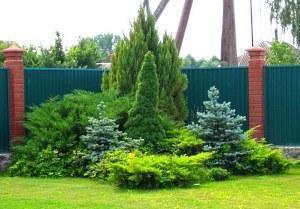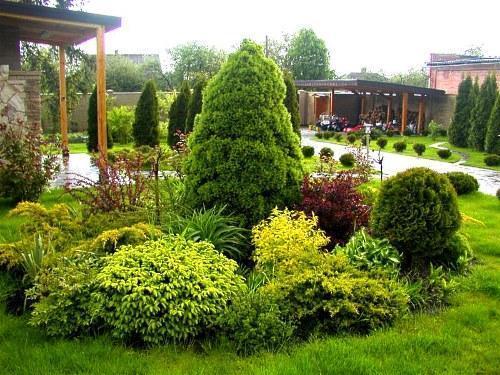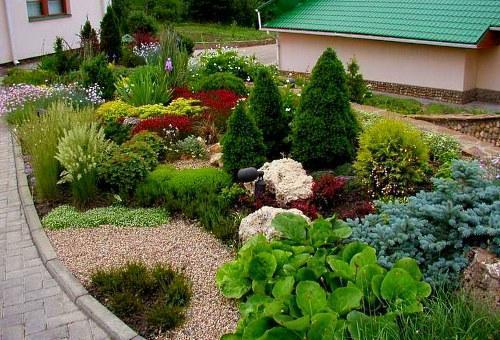Coniferous beds - evergreen oases in landscape design
 Conifers are used as landscaping of alleys, wings, and personal plots. Ephedra have several advantages over other plants.
Conifers are used as landscaping of alleys, wings, and personal plots. Ephedra have several advantages over other plants.
Benefits of a coniferous flower bed:
- The main advantage of a bed with conifers is its evergreen appearance at any time of the year. It is enough to look at the photo of a bed of conifers to make sure that this postulate is correct;
- Availability of flower bed design development and subsequent preparation for planting;
- Ease and ease of care behind the flower bed with conifers;
- The ability to preserve plantings in a flower bed for several years. Conifers are predominantly perennial plants and do not require annual renewal;
- Saving material costs for creating a flower bed and caring for it;
- Saving time to maintain the appearance of the coniferous flower bed at the proper level.
The choice has been made, it's time to start forming a flower bed of conifers. This process consists of several stages.
Arrangement of coniferous flower beds:
- Design development of a flower bed with conifers;
- Selection of conifers;
- Elaboration of the coniferous plant bed scheme;
- Soil preparation for a flower bed;
- Planting the conifers themselves.
Despite the richness of the choice of conifers, in landscape design there are uniform principles for the formation of a flower bed from conifers.
Coniferous flower bed design principles:
- The priority is given to undersized and compact plants;
- The game is based on the contrast of form and color;
- Slow-growing dwarf conifers are planted against the background of ground cover plants;
- A lawn and an alpine slide serve as a base for the flower bed;
- The addition of a coniferous flower bed is stones;
- Bark is chosen as a decor for a flower bed from conifers.
By observing these principles, you can avoid many common mistakes of amateur gardeners. For example, plants are planted without considering the ability to grow further and too close to each other. In the future, this leads to the fact that some of them grow quite quickly, blocking the access of sunlight to other plants and even the dwelling house itself. As a result, disharmony in the size of the plants becomes noticeable, and the general appearance of the flower bed loses its original charm.

Pine, spruce, fir or juniper are chosen as the basis for a bed of conifers.
Shrubs that combine with conifers are rhododendrons, barberry, common heather, spirea, erica, boxwood.
Perennial herbaceous plants such as cereals and ferns are also suitable for the composition.
Phlox, thyme, bryozoan, creeping tenacious, sedums are chosen as ground cover plants that form the background of the flower bed.
Photos illustrate the combination of plants in beds with conifers better than any descriptions.

When preparing soil for a flower bed, it should be borne in mind that a feature of conifers is their unpretentiousness and the ability to take root in any land. Nevertheless, it will be wiser to take care of the soil in advance and mix the leaf or soil sod, adding peat and sand to them. Special coniferous mixes available from gardening stores are also useful.
Pits for plants are dug about 60-70 cm deep and lined with prepared potting mixes. Pebbles are used as drainage.
After planting conifers, it is necessary to compact the soil and mulch. An additional layer of earth can be added if necessary.
The coniferous plant bed scheme, as a rule, involves 12 design options. Every gardener, be it amateur or professional, can develop his own composition. But before proceeding with this, it is advisable to familiarize yourself with their main types.

- Compact... In this scheme, coastal juniper is planted in the foreground, mountain pine and western thuja are placed in the middle of the flower bed. A feature of this composition is its small size, which allows arrange along the fences, and thus decorate them.
- Big... The flower bed is ideal for large spaces and is usually placed in areas adjacent to fences. In this composition, 2 varieties of common juniper are planted along the fence, and in front of them is the western thuja, on its sides are junipers, in the middle there is mountain pine, barberry and again juniper, but already scaly, and further along the edge - horizontal 2-x juniper species;
- Horizontal... Its feature is the mandatory requirement for a flat, flat surface for planting. In its creation, 3-4 types of junipers are used, for example, molded virgin, Prince of Wales, Andorra Compact;
- Flowerbed in forest style... Allows you to create the impression of a natural landscape. For such a natural flower bed, rocky juniper and mountain pine, as well as Canadian and ordinary spruce are ideal.
I have long wanted to arrange a flowerbed of evergreens in the country. After all, when you come to the dacha in winter, everything seems somehow boring and dull. But I didn't know how to do it in practice, which plants to choose and what to combine them with. The article describes everything in detail, selected bright photos. I will definitely try. From evergreens I like boxwood, thuja; from ground cover plants - phlox, thyme. Dear summer residents, maybe someone has a beautiful evergreen flower bed? What plants are best to plant so that they are not very picky?